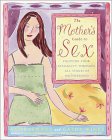
The Mother's Guide to Sex. Enjoying Your Sexuality Through All Stages of Motherhood
By Anne Semans and Cathy Winks
Three Rivers Press; ISBN: 0-8129-3274-9; 14.00 US$; 22.00 CAN$; 2001
Reviewed by Annette Fuglsang Owens, MD PhD
Click on the cover to buy this book.
Anne Semans and Cathy Winks, authors of The New Good Vibrations Guide to Sex and The Woman's Guide to Sex on the Web have recently published The Mother's Guide to Sex, targeting women in all stages of motherhood, beginning with conception.
In this book, based upon over seven hundred responses to an on-line
survey, we hear women of all walks of life discuss how pregnancy and raising
young children have affected their love lives. These are married, single,
heterosexual, lesbian, adoptive and biological mothers sharing useful tips
about how to nurture an interest in sex and to make sex a priority despite
the endless tasks of raising children. Unlike other resources with a similar
focus, this book is unusual in that it does not suggest that you have to
escape your children in order to find time for intimacy, e.g. going out
alone, getting away for a weekend, etc. Instead Semans and Winks offer
sound advice on how to continue your sex life as you are living with your
children.
The Mother's Guide to Sex is divided into four parts: 1) Building Blocks of Sexuality deals with important components of sexuality, such as self-image, self-esteem, masturbation, desire, and communication; 2) The ABCs of Becoming a MOM covers the basics of conception, pregnancy, and the postpartum period; 3) Reinventing Sex as a Parent offers practical suggestions on how to maintain a satisfying sex life and focuses on how the experience of sex may have changed with the arrival of a baby; 4) Raising Sexually Healthy Children lists age-appropriate guidelines for how to address sexuality issues with infants and toddlers, preschoolers, elementary school children, children going through puberty, and finally with teenagers. All sections deal with key topics important for most young families.
The arrival of a new baby does not necessarily mean that a mother's sexual desire will vanish and that any pre-existing sex life will reduce to a minimum:
"I feel sexier in a different way than I used to. I feel more experienced and whole and less like a seductive teenybopper."
"I feel even more comfortable with my sexuality because I feel more connected with the whole circle of life. It sounds corny, but it's true."
"I feel more sensual. I feel very connected to the earth, I feel very
spiritual. This has affected my sexuality immensely."
Not all voices are this positive and frequently the baby blues do reduce new mothers' sexual desires. After all, low sexual desire is one of women's most frequent concerns. The Mother's Guide to Sex devotes an entire chapter to how and why sexual desire may decrease as the family grows. In their casual style, Semans and Winks offer various solutions on how to adjust to these changes; and for those interested, they provide suggestions on how to rekindle passion.
Another chapter describes the special challenges that single mothers may meet. I am not familiar with other books having incorporated this topic, making this Guide to Sex useful for women in a variety of settings.
The final section on how to raise sexually healthy children exceeds many other current books on this particular issue. National research has shown that children who speak openly and honestly with their parents about sexuality are far less likely to engage in premature sexual intercourse than those who are not (Darling & Hicks "Parental Influence on Adolescent Sexuality: Implication for Parents as Educators" Journal of Youth and Adolescence, June 1982). Therefore, it is believed that parents are the best source of information about sexual health to their children. Semans and Winks not only offer detailed advice on what children should know about sexuality at various age levels and developmental stages. They also give many practical tips on how to embrace these challenges as parents. Finally, the authors provide lists of resources (Internet, books, professional organizations) where readers can find additional information on the many topics addressed in this book.
In conclusion, The Mother's Guide to Sex provides pertinent information
to mothers and their partners. It covers important issues ranging from
conception to the challenge of addressing sexuality issues with teenagers.
I recommend the book to anyone considering starting a family and to individuals
who already have children.